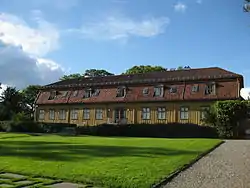Tøyen
Tøyen is a residential area in the central parts of Oslo, Norway, part of the borough of Gamle Oslo.



Architects: Einar Myklebust and Gunnar Fougner
Location
There are two different stations which carry the name Tøyen. Tøyen Railway Station is located on the Gjøvik Line, while Tøyen T-bane Station on the shared stretch just east of the downtown area. The railway station is about 750 metres northeast of the subway station.
Above the Tøyen subway station is a shopping centre. Apart from the Munch Museum, there is a park north of the subway station with botanical gardens and paleontological, geological and zoological museums.
Tøyen is known for its considerable social problems. One out of three children lives beneath poverty level. The school district counts less than 300 pupils, while the area has more than 1,000 council flats. 60% of the locals inhabit flats with only one or two rooms. When the capital's working class settled here in the late 1800s, their lives were troubled by poverty, miserable housing conditions and alcohol. To some extent this is still the case. While flats at the fringes of Tøyen have been nicely upgraded in later years, the council flats around the centre are the first stop for newly arrived refugees. Traumatized families with several children are housed together with recently released criminals, while drug addicts and the mentally ill are expected to just get by, unaided, after lengthy stays in institutions.[1]
Tøyen Manor
The area is named after Tøyen Manor (Tøyen hovedgaard), one of the former large estates in Oslo. Tøyen was originally a property owned by the Nonneseter Abbey. The current Manor House was built in 1679 and is one of Oslo's oldest timber buildings. Norway's Chancellor Jens Bjelke acquired the property about 1620. When the Chancellor died 1659, and his youngest son Jørgen Bjelke inherited the estate. City magistrate Johan Lausen Bull sold the farm to King Frederik VI in 1812, whereupon the king gave the farm to the University of Christiania. In 1814 work began on the University Botanical Garden.[2]
The main building was restored in 2006-07. The interior was restored to the period from the late 1700s to early 1800s. Today the former the newly restored manor provides reception rooms for the University of Oslo. Tøyen Manor is situated in the University Botanical Garden. The house is currently owned by the Museum of Natural History at the University of Oslo.[3]
The name
(Norse Tǫðin, from originally *Taðvin). The first element is tað n 'manure', the last element is vin f 'meadow'. The meaning is 'the fertilized meadow'.
References
- Rønnaug Jarlsbo (17 August 2012). "Hva er det med Tøyen?". Dagbladet.
- The Botanical Garden (Naturhistorisk Museum, Universitetet i Oslo
- Tøyen Hovedgård (Naturhistorisk Museum, Universitetet i Oslo
| Wikivoyage has a travel guide for Oslo/Inner East. |
